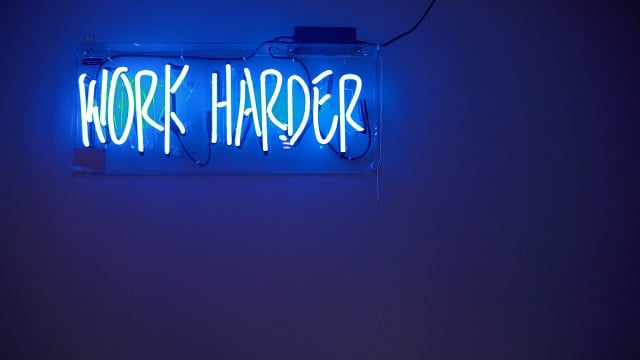
If you are constantly on the limit due to stress and exhaustion and still keep going, you suffer from burn-on. Here you can find out what the syndrome is all about and what helps against it.
Burnout is a severe mental and physical state of exhaustion that eventually leads to nothing working. If this crash does not occur, and instead one continues to “function” as before, despite permanent tension and chronic exhaustion, specialists speak of burn-on syndrome – a preliminary stage of being completely burned out.
What is burn on?

(Photo: CC0 / Pixabay / 0fjd125gk87)
While burnout, according to psychotherapist Timo Schiele, is characterized by a “negative spiral of overwork, ever-decreasing performance and the attempt to compensate for this by doing more work”, burn-on does not escalate in this way. Those affected by burn-on never experience a low point in the spiral where they realize that things can no longer go on as before. The feeling of being completely “burned out” does not occur.
Instead, burn-on syndrome is a “chronic form of exhaustion depression” during which those affected continue to pursue their tasks and sometimes even try to push their stress limit further up. The psychologist Matthias Diesch explains that a burnout involves the “definitive breakdown”, whereas its precursor, the burn-on, is characterized by the fact that a certain fire is still blazing. Those affected continue to burn with their last ounce of strength instead of burning out completely. But completing tasks no longer brings joy and fulfillment, because it only happens automatically – not motivated by personal values or goals.
According to Matthias Diesch, these physical symptoms can occur in addition to chronic exhaustion and constant stress:
- Trouble sleeping (not being able to fall asleep and waking up early)
- high blood pressure
- nausea
- dizziness
- heavy limbs
- powerlessness
- tinnitus
- flicker in the eyes
Mental signs are:
- Despair
- sense of futility
- lack of perspective
- lack of enthusiasm and zest for life
- lack of satisfaction
Where does burn-on come from and what are the consequences?

(Photo: CC0 / Pixabay / Pexels)
Burn-on sufferers live their everyday life – whether professionally or privately – mostly in work mode. They want to work through both commitments at work and actually happy matters in private life, such as getting presents or calling their girlfriends, as efficiently as possible. They subject their entire lives to extreme performance demands, which means that they can hardly escape permanent stress. As a result, they find it difficult to truly switch off, and often even the breaks they take are designed solely to maintain their efficiency.
Matthias Diesch explains that this results in a situation as if you were always driving in the fast lane, always pressing the gas pedal and not realizing that there is actually hardly any fuel left in the tank. According to psychotherapist Bert te Wildt, the physical consequences of this condition can include high blood pressure, which is a precursor to strokes and heart attacks, and often extreme tension and headaches.
Several factors favor a burn-on. These can be both personal characteristics and problematic structures in the working world:
- For example, people who are susceptible to burn-on syndrome are those who have a strong sense of responsibility, a pronounced willingness to spend more and are career-oriented. It is also often the case that those affected are people who have not learned to distance themselves from performance requirements at a young age, so that they now have difficulties in not coping with everything in life as well as in work mode.
- The development of such tendencies can not only be traced back to the individual personality, but also to the pressure within the meritocracy. Psychologist Matthias Diesch explains that even at school, with its grading system, you get the feeling that success is only possible through constant performance. And if you meet demanding superiors in your professional life who offer neither praise nor recognition, many would conclude that they have not done enough work to deserve appreciation. You then feel the pressure to perform and always want to achieve more.
- Bert te Wildt sees factors in the structures of the working world that promote burn-on syndrome. On the one hand, there are many precarious work situations, i.e. jobs where working 40 hours a week is not enough to make ends meet. On the other hand, a high workload in some areas such as medicine or science would bring a competitive advantage over the strong competition.
This is how you can (have) treat and prevent burn on

(Photo: CC0 / Pixabay / Peggychoucair)
Overworking is common in a society defined by performance and values strongly linked to money and material things. It seems normal to always work in work mode. But those who suffer from burn-on live on a fine line between permanent stress and burnout. It is therefore important not to let burn-on occur in the first place.
Here’s what you can do to avoid burn-on syndrome:
- Create a work-life balance for yourself. Find a meaningful hobby that is not primarily about performance. For example, try something creative, like crafting with natural materials you’ve collected from forest bathing. Exercise hobbies such as cycling or hiking allow you to be more aware of your body and thus recognize physical symptoms of stress.
- Learn to stick to work and break times. It starts with following a regulated day-night rhythm. For example, it can be helpful to avoid digital media in your morning and evening routine, which often tempt us to work outside the office and also keep us constantly energized.
- Try different methods of slowing down, such as relaxation techniques like proper breathing, progressive muscle relaxation (PME) or mindfulness exercises.
Even if you suspect that you are already acutely suffering from burn-on syndrome, you can try these tips. However, those affected often tend to want to work through methods for relaxation and deceleration as efficiently as possible in order to be able to go directly to the next task.
But to avoid slipping into burnout, it is important not to hesitate and seek treatment from professionals:
- Therapy: The support of a psychologist or psychotherapist will initially help you to become aware of the problem. It also allows you to explore why you spend your entire life in work mode. Knowing the causes is an important prerequisite for effective treatment.
- Cure: As part of a cure, you withdraw from your usual working and living environment, which is geared towards efficiency and performance. This gives you the opportunity to focus your awareness on yourself. You can do sports during the cure and become aware of the strength but also the exhaustion of your body. This will help you be more aware of your body’s stress signals. You can apply for a cure from your health insurance company through your doctor.
The components of your burn-on treatment are individually adapted to you and your situation. But two basic measures against burn on are:
- Lifestyle change: Burn-on means that your whole life is consumed by work and efficiency. Therefore, it is inevitable that you will make significant changes in your lifestyle. This may include scaling back work, such as during a sabbatical, relaxing for its own sake, and increasing focus on non-merit-related hobbies and socializing.
- Distancing: As part of these lifestyle changes, it’s important that you learn to differentiate yourself. This includes starting to say no more often. Saying no enables you to live more independently and to decide how you really want to spend your time. Dissociation can also mean ending toxic friendships.
Read more on Techzle.com:
- Overcoming depression: How you can help those affected
- Stress management: These methods and exercises will help you
- Boreout: when the work doesn’t fulfill you